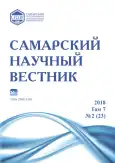Oil-oxidation properties of Micrococcus bacteria isolated from the Nakhodka Bay seawater of the Sea of Japan
- Authors: Golozubova J.S.1, Buzoleva L.S.1, Bogatyrenko E.A.1, Kim A.V.1, Eskova A.I.1
-
Affiliations:
- Far Eastern Federal University
- Issue: Vol 7, No 2 (2018)
- Pages: 13-16
- Section: 03.02.00 – General Biology
- URL: https://journals.rcsi.science/2309-4370/article/view/21700
- DOI: https://doi.org/10.17816/snv201872101
- ID: 21700
Cite item
Full Text
Abstract
This paper shows the oil-oxidizing ability of Micrococcus bacteria isolated from the Nakhodka Bay surface waters of the Peter the Great Gulf, the Sea of Japan. Micrococcus Bacteria are known to be the most active destructors of petroleum hydrocarbons in natural biotopes, contaminated objects. Voroshilova-Dianova liquid containing 2,5% oil or oil products was introduced into sterile penicillin bottles with 105 cells of the investigated bacteria. The ability to destruct petroleum hydrocarbons by bacteria of this genus was studied using a gravimetric method during 30 days. Destruction of oil, gasoline, fuel oil and diesel fuel was shown. Micrococcus bacteria showed a high oil-oxidizing ability and decompose 65–99,9% of oil and oil products within 30 days. Gasoline was the source of petroleum hydrocarbons with the greatest ability to utilize this genus of bacteria. The destruction of this hydrocarbons source by bacteria on days 15–20 was about 99% of the initial concentration. The lowest ability of destruction by Micrococcus bacteria was revealed for diesel fuel.
Full Text
##article.viewOnOriginalSite##About the authors
Julia Sergeevna Golozubova
Far Eastern Federal University
Email: know-26@mail.ru
postgraduate student of Ecology Department
Russian Federation, VladivostokLyubov Stepanovna Buzoleva
Far Eastern Federal University
Email: buzoleva@mail.ru
doctor of biological sciences, professor, professor of Biodiversity and Marine Bioresources Department
Russian Federation, VladivostokElena Aleksandrovna Bogatyrenko
Far Eastern Federal University
Email: jokonda@mail.ru
candidate of biological sciences, associate professor of Biodiversity and Marine Bioresources Department
Russian Federation, VladivostokAlexandra Vyacheslavovna Kim
Far Eastern Federal University
Email: kim-sandra@mail.ru
postgraduate student of Ecology Department
Russian Federation, VladivostokAlena Igorevna Eskova
Far Eastern Federal University
Author for correspondence.
Email: alena-esya@mail.ru
postgraduate student of Biodiversity and Marine Bioresources Department
Russian Federation, VladivostokReferences
- Vashchenko M.A. Pollution in Peter the Great Bay, Sea of Japan, and its biological consequences // Russian Journal of Marine Biology. 2000. Vol. 26 (3). P. 155-166.
- Наумов Ю.А. Антропогенез и экологическое состояние геосистемы прибрежно-шельфовой зоны залива Петра Великого Японского моря. Владивосток: Дальнаука, 2006. 300 с.
- Ростов И.Д., Рудых Н.И., Ростов В.И., Воронцов А.А. Тенденции климатических и антропогенных изменений морской среды прибрежных районов России в Японском море за последние десятилетия // Известия ТИНРО. 2016. Т. 186. С. 163-181.
- Tan N.C.G., Prenafeta-Boldu F.X., Opsteeg J.L., Lettinga G., Field J.A. Biodegradation of azo dyes in co cultures of anaerobic granular sludge with aerobic aromatic amine degrading enrichment cultures // Appl. Microbial. Biotechnol. 1999. Vol. 51. P. 865-871.
- Миронов О.Г. Бактериальная трансформация нефтяных углеводородов в прибрежной зоне моря // Морской экологический журнал. 2002. Т. 1, № 1. С. 56-66.
- Wackett L.P. Biodegradation of fuel components // Environ. Microbiol. 2008. Vol. 10. P. 1380-1381.
- Иванов В.П., Сокольский А.Ф. Научные основы стратегии защиты биологических ресурсов Каспийского моря от нефтяного загрязнения. Астрахань: Изд-во КаспНИРХа, 2000. 181 с.
- Сазыкин И.С., Сазыкина М.Л., Чистяков В.А., Кленкин А.А., Павленко Л.Ф. Утилизация углеводородов, смол и асфальтенов нефтеокисляющими микроорганизмами керченского пролива // Вода: химия и экология. 2011. № 1. С. 29-34.
- Смолина (Макогина) И.С., Христофорова Н.К. Оценка качества морской воды заливов Восток и Находка // Географические и геоэкологические исследования на Дальнем Востоке. Вып. 2. Владивосток, 2006. С. 141-148.
- Галышева Ю.А. Биологические последствия органического загрязнения прибрежных морских экосистем российской части Японского моря // Известия ТИНРО. 2009. Т. 158. С. 209-227.
- Нигматулина Л.В., Кику Д.П., Черняев А.П. Оценка воздействия антропогенной деятельности на залив Находка (Залив Петра Великого, Японское море) // Известия ТИНРО. 2011. Т. 166. С. 219-230.
- Доклад об экологической ситуации в Приморском крае в 2016 году // Приморская газета. 2017. № 74 (1412). С. 6-29.
- Бузолева Л.С., Смирнова М.А., Безвербная И.П. Биологические свойства морских нефтеуглеводородокисляющих бактерий из прибрежных акваторий дальневосточных морей с разным характером загрязнения // Известия ТИНРО. 2008. Т. 155. С. 210-218.
- Бойченко Т.В. Химико-экологическая и микробиологическая оценка качества морских поверхностных вод Южного Приморья: дис. … канд. биол. наук. Владивосток, 2009. 150 с.
- Бузолева Л.С. Патент № 2520084 «Способ учета нефтеокисляющих бактерий в морской воде».
- Ворошилова А.А., Дианова Е.В. Окисляющие нефть бактерии - показатели интенсивности биологического окисления нефти в природных условиях // Микробиология. 1952. Т. ХХI, вып. 4. С. 408-415.
- Винникова О.И., Самойлов А.М., Попова Ю.В. Выделение и идентификация бактерий: методические рекомендации для студентов биологического факультета специализации «Микробиология и вирусология». Харьков: ХНУ имени В.Н. Каразина, 2011. 60 с.
- Хоулт Дж., Криг Н., Смит П. Определитель бактерий Берджи. В 2 т.: Т. 1, Т. 2. М.: Изд-во «Мир», 1997. 800 с.
- ПНДФ 14.1:2.116-97 Методика выполнения измерений массовой концентрации нефтепродуктов в пробах природных и сточных вод методом колоночной хроматографии с гравиметрическим окончанием.
- Жижин К.С. Медицинская статистика: учебное пособие. Ростов-на-Дону: Феникс, 2007. 160 с.
Supplementary files







